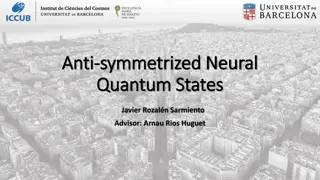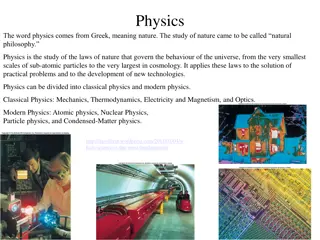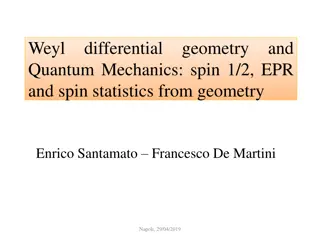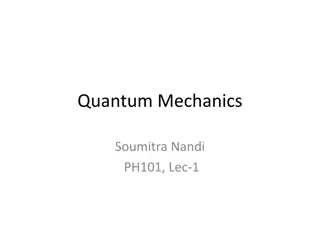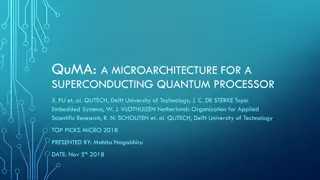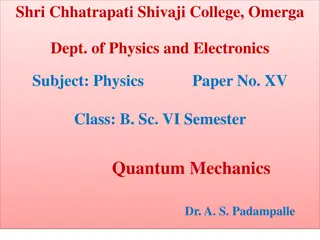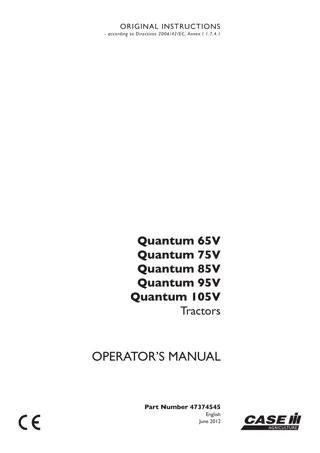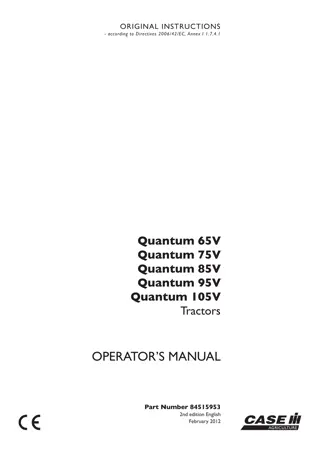Inadequacies and Origins of Quantum Mechanics
Classical physics fails in the atomic realm, leading to the development of quantum mechanics. Max Planck's introduction of energy quanta and subsequent theories by Heisenberg and Schrödinger revolutionized our understanding of atomic phenomena.
Download Presentation

Please find below an Image/Link to download the presentation.
The content on the website is provided AS IS for your information and personal use only. It may not be sold, licensed, or shared on other websites without obtaining consent from the author.If you encounter any issues during the download, it is possible that the publisher has removed the file from their server.
You are allowed to download the files provided on this website for personal or commercial use, subject to the condition that they are used lawfully. All files are the property of their respective owners.
The content on the website is provided AS IS for your information and personal use only. It may not be sold, licensed, or shared on other websites without obtaining consent from the author.
E N D
Presentation Transcript
()mv Shri Prakash Gupta Assistant Professor, Department of Physics, Harish Chandra P.G. College, Varanasi - 221001
Inadequacies of Quantum Mechanics and Origin of Quantum Mechanics : Classical physics is based on Newton s three laws. The classical mechanics explained : the motion of classical bodies e.g. macroscopic and microscopic terrestrial bodies moving with the speed v<<c. the wave motion and fluid motion. the motion of the objects which are observable directly or with the help of instruments like microscope. But classical concepts do not hold good in the region of atomic dimensions, so the classical laws can not : be applied directly to the motion of electron, failed to explain the spectrum of hydrogen atom, failed to explain the spectral distribution of black body radiation, failed to explain photoelectric effect and Compton effect.
In 1900, Max Planck introduced the new concept that the emission or absorption of electromagnetic radiation takes place in the form of discrete packets of energy called quanta having energy h , where is the frequency of radiation and h ( 6.62 10 Js) is called Planck s constant. This concept led to a new mechanics called quantum mechanics . Planck was able to explain the black body radiation (spectrum) by using quanta hypothesis. Einstein in 1905 used this concept to explain photoelectric effect. Thus dual nature (wave particle) of electromagnetic radiation become established. Planck s quantum hypothesis explained many atomic phenomena successfully. This theory is know as old quantum theory and it is a mixture of classical and non-classical concepts. It failed to explain complex atomic systems.
The newer theory of quantum mechanics is based on two principles : the Heisenberg s uncertainty principle and the Bohr s complementary principle. Thus new quantum mechanics has : matrix mechanics developed by Heisenberg in 1925, and wave mechanics developed by Schr dinger in 1926. By using quantum theory, many problems of atomic physics have been solved but it has some limits. In 1947, a more developed theory was accepted know as quantum field theory .
Photoelectric Effect : The phenomenon of emission of electrons from a metallic surface when light of suitable frequency falls on it, is called photoelectric effect. The emitted electrons are called photo-electrons. This phenomenon was discovered by Hertz and it was experimentally verified by Hallwachs-Lenard, J.J. Thomson, R.A. Millikan and others. Photoemission depends upon the metal used : in case of alkali metals, emission takes place even by visible light, in case of metals like zinc, cadmium, etc., emission occurs only by U.V. light. Experimental Arrangement : Fig.(1) shows the experimental arrangement to observe the photoelectric effect. Two electrodes: cathode C, made of photo- metal and anode A are enclosed in an evacuated quartz bulb. When no light falls on the cathode, no current flows, but when monochromatic light of suitable frequency falls on cathode the current starts to flow which shows deflection I galvanometer. This current is called photoelectric current .
The photoelectric current depends upon the following factors: 1. the potential difference between two plates (C and A), 2. the intensity of incident radiation, 3. the frequency of incident radiation, 4. the photo-metal used. The effect of each one of these factors can be studied by keeping others constant. 1. Effect of Potential Difference : For a given photo cathode, keeping the intensity and frequency of radiation constant, if the positive potential of the anode is increased the number of photoelectrons increases and hence the photo-current increases. When the p. d. between the plates is large enough, all the electrons emitted by the cathode C reach the anode A. Now if we increase the p. d. further between the plates, the current does not increase. This maximum value current is called the saturation current.
It may be noted that a little current flows even when the anode A is made slightly negative. It happens because the emitted electrons have fight velocity and are able to overcome the force of small repulsion. A variation of photo-current with the p. d. between the plates is shown in the Fig. (2) : Fig. (2)
The negative potential on the anode for which photoelectric current becomes zero, is called stopping potential (V ) or cut off potential . At this potential the electron with highest kinetic energy (K.E.) or maximum velocity is unable to reach the anode A. If m be the mass of the photo-electron emitted with velocity v then kinetic energy associated with it K.E. = ( )mv .. (1) The stopping potential V just balances this kinetic energy. Therefore, if e be the electronic charge, then by the law of conservation of energy, we can write (K.E.)max = e V ..(2) or [( )mv ]max = e V or (v)max = [2 e V /m] ..(3) This relation shows that stopping potential is a measure of maximum kinetic energy of emitted electrons.
2. Effect of Intensity : For a given cathode metal and keeping the potential at anode and frequency of incident light constant, if we vary the intensity of incident light, the photoelectric current increases linearly, i.e. photoelectric current is directly proportional to the intensity of the incident light. Thus, the number of photoelectrons ejected from the photo-cathode is proportional to the intensity of incident light. The stopping potential (V ) or (K.E.)max of photoelectrons does not depend on the intensity of incident light. 3. Effect of Frequency : Using the same cathode and keeping the intensity of light constant, if the frequency of light is varied, it is found that stopping potential is directly proportional to the frequency of incident light i.e. higher the frequency of incident light, higher is the value of stopping potential, as shown in Fig.(3).
Fig. (3) The frequency of incident radiation plotted against corresponding stopping potential is shown in Fig. (4): Fig. (4)
The graph obtained is a straight line with slop h/e and the intercept of this line on the frequency axis is . At = , the stopping potential is zero. The frequency at which the stopping potential is zero, is called threshold frequency for the photo-metal used. Therefore, threshold frequency is defined as the minimum frequency of incident light below which photoelectric emission does not occur how so ever high the intensity of incident light may be. The threshold frequency is different for different photo-metals. 4. Effect of Photo-metal : For the same intensity and frequency of incident light, the graph between stopping potential and frequency for different photo- metals, straight lines are obtained as shown in Fig.(5). Thus, different photo-metals have different threshold frequency. In other words, threshold frequencies depend on the nature of photo-metals. Fig. (5)
Laws of Photoelectric Emission : The experimental observations on photoelectric effect may be summarized as follows which are knows as the fundamental laws of photoelectric emission : 1. The rate of emission of photoelectrons is directly proportional to the intensity of incident light. 2. The kinetic energy of the emitted electrons have values between zero and a definite maximum. The maximum kinetic energy of the photoelectron is independent of intensity of incident light. 3. The maximum kinetic energy of the photoelectrons depends on the frequency of incident light. 4. The emission of photoelectrons can not occur if the frequency of incident light is below a certain frequency , howsoever strong be the intensity of light. This frequency is called threshold frequency and is a characteristic frequency for the photo metal used. 5. Photoelectrons are emitted almost instantaneously even when the intensity of incident light is very poor. There is no time lag between the incidence of radiation and emission of electrons.
Einsteins Photoelectric Equation : The theoretical explanation of photoelectric effect was given by Einstein in 1905. He based his arguments on Planck s law of quantum theory of light, according to which the emission and absorption of radiation takes place in small packets of energy, called quanta or photons, rather than continuously. Einstein further assumed that light is not only emitted in quanta but also travels as quanta, i.e., the photon preserve their identity throughout their life. He postulated that when a photon collides with an electron of the metal, it transfers its energy to the electron which is an all or none process i.e., either the photon gives whole of its energy h to the electron or no energy at all. When a photon of energy h is incident on a metal surface, its energy is used up in two ways : 1. A part of energy of the photon is used in ejecting out the electron from the binding forces of the nucleus. This energy used in doing work in ejecting the electron from the atom is expressed as the work function of the photo-metal. Thus, the work function of a photo- metal is defined as the minimum amount of energy required to liberate electron from the bondage of its atom . 2. The remaining energy of the photon is used to impart kinetic energy to the same electron. It may be noted that the energy of the photon is not divided, but the whole energy of a photon is used up by the same electron in ejecting it out from the parent atom and imparting it a velocity.
If W be the work function of the photo-metal, m be the mass of electron and v the velocity of electron, then we have : Energy of photon = Work function + K.E. of electron or h = W + ( )mv ..(1) This is know as Einstein s photoelectric equation. The kinetic energy of the ejected electron increases with increase in frequency and decreases with decrease of frequency of incident radiation of light. Finally, at a particular frequency called threshold frequency, kinetic energy will be zero, i.e., at = , ( )mv = 0. Therefore, from eq.(1), we get h = W. ..(2) Substituting the value of W in eq.(1), we get h = h + ( )mv or ( )mv = h( - ) ..(3) This is Einstein s photoelectric equation. xxx




